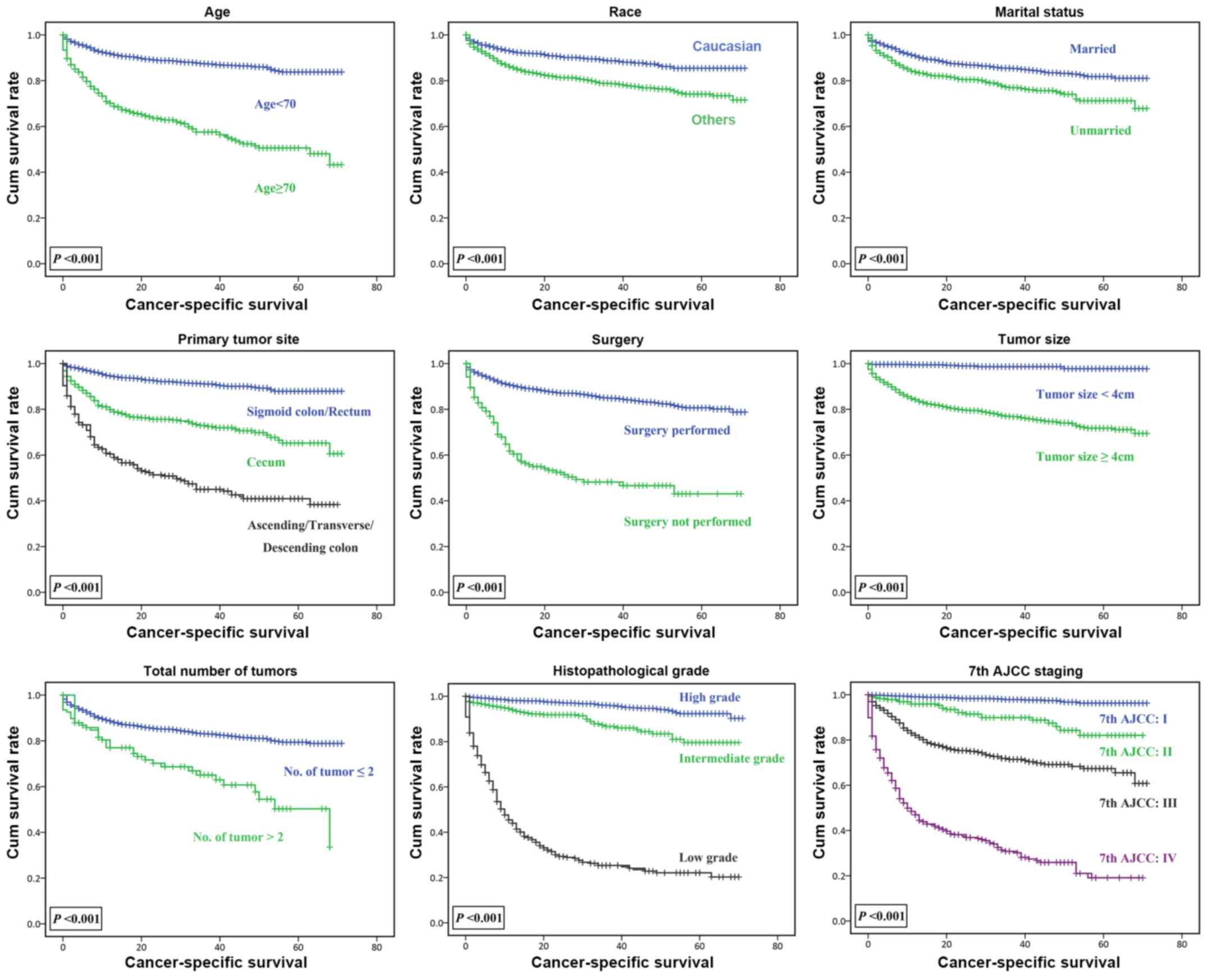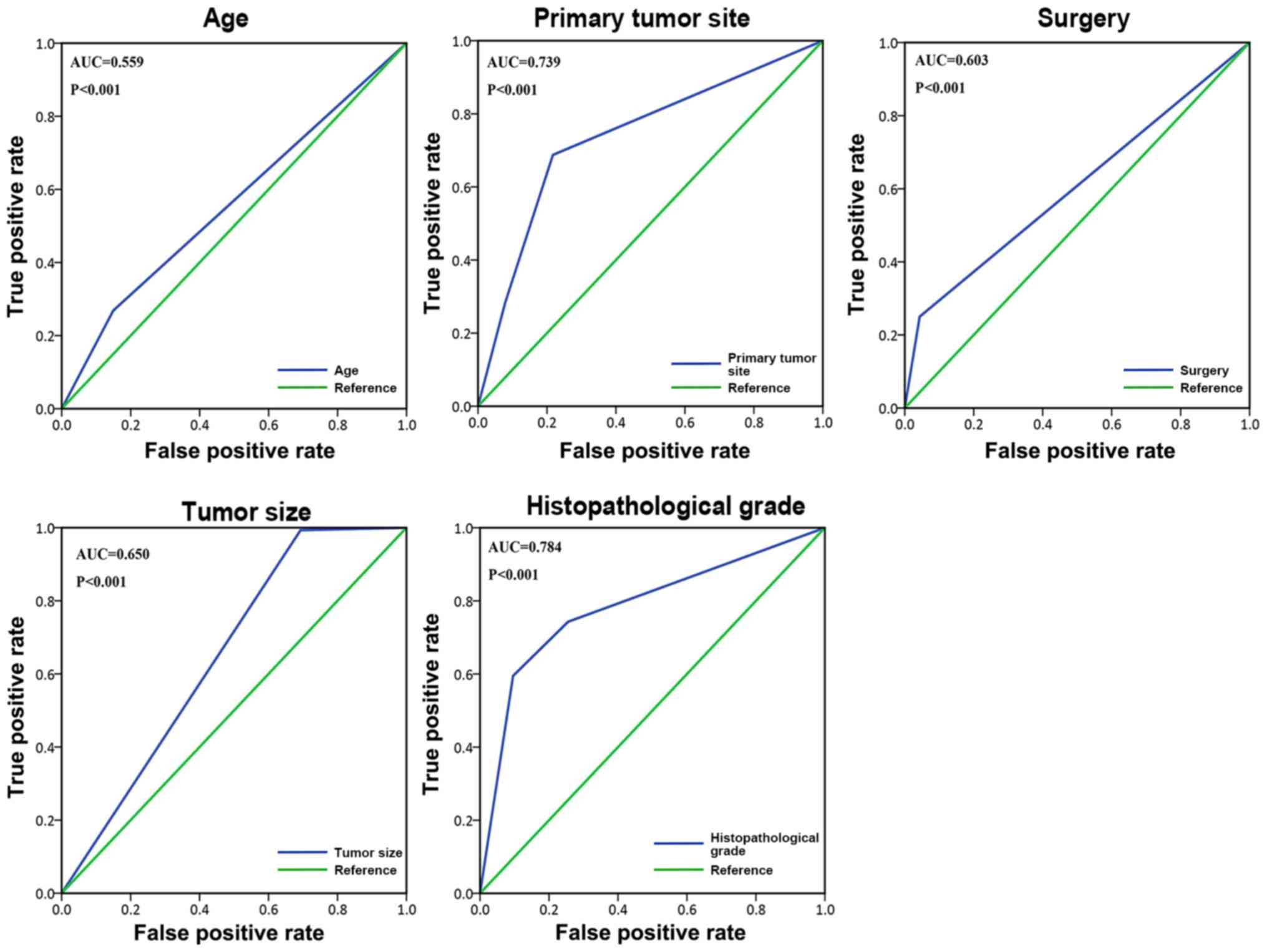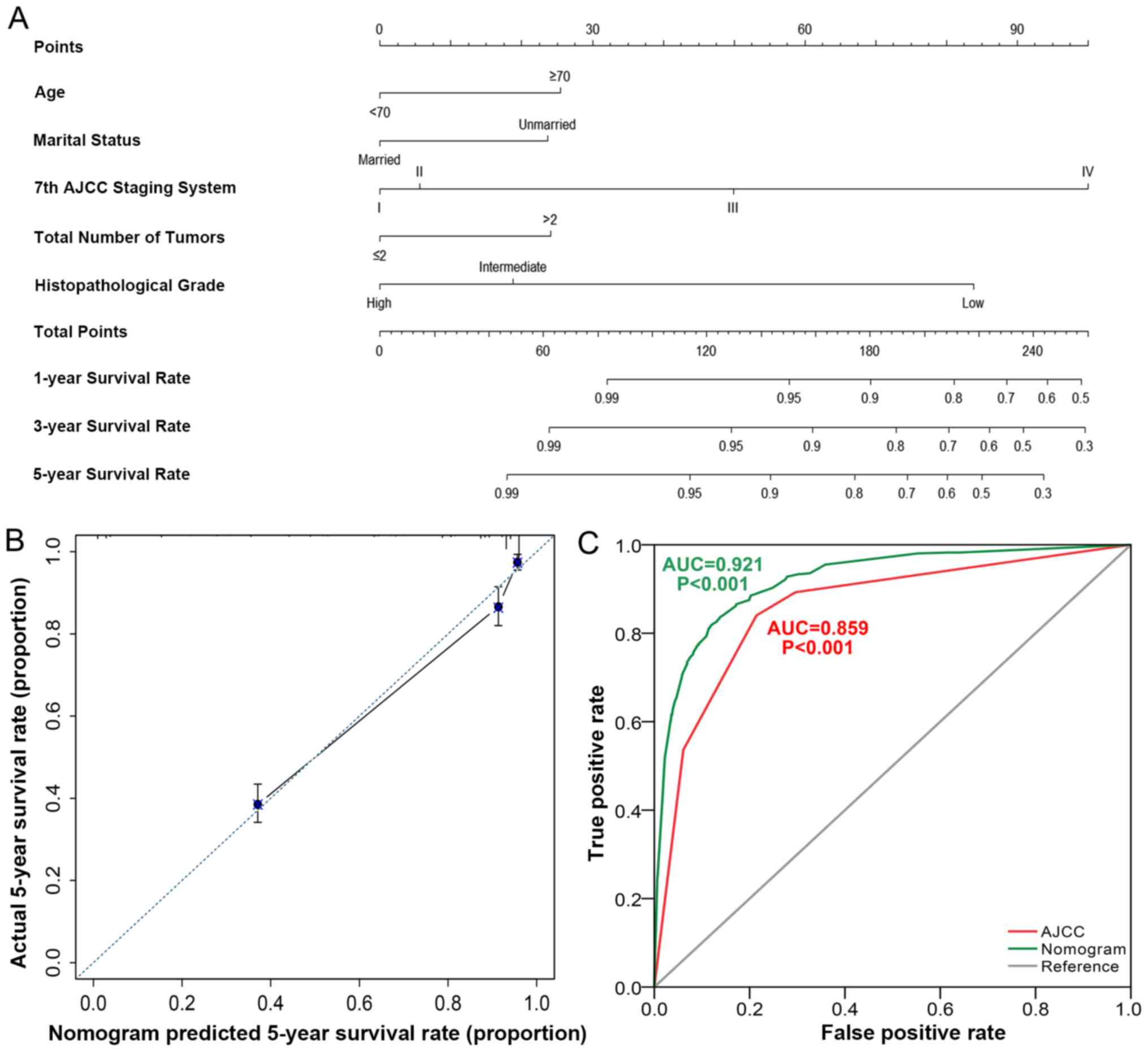|
1
|
Dasari A, Shen C, Halperin D, Zhao B, Zhou
S, Xu Y, Shih T and Yao JC: Trends in the incidence, prevalence,
and survival outcomes in patients with neuroendocrine tumors in the
united states. JAMA Oncol. 3:1335–1342. 2017. View Article : Google Scholar : PubMed/NCBI
|
|
2
|
Ter-Minassian M, Chan JA, Frauenhoffer CS,
Hooshmand SM, Asomaning K, Lin X, Christiani DC and Kulke MH:
Prospective analysis of clinical outcomes and prognostic factors in
patients with neuroendocrine tumors (NETs). J Clin Oncol. 28:4044.
2010. View Article : Google Scholar
|
|
3
|
Ter-Minassian M, Chan JA, Hooshmand SM,
Brais LK, Daskalova A, Heafield R, Buchanan L, Qian ZR, Fuchs CS,
Lin X, et al: Clinical presentation, recurrence, and survival in
patients with neuroendocrine tumors: Results from a prospective
institutional database. Endocr Relat Cancer. 20:187–196. 2013.
View Article : Google Scholar : PubMed/NCBI
|
|
4
|
Toste PA, Kadera BE, Tatishchev SF, Dawson
DW, Clerkin BM, Muthusamy R, Watson R, Tomlinson JS, Hines OJ,
Reber HA and Donahue TR: Nonfunctional pancreatic neuroendocrine
tumors <2 cm on preoperative imaging are associated with a low
incidence of nodal metastasis and an excellent overall survival. J
Gastrointest Surg. 17:2105–2113. 2013. View Article : Google Scholar : PubMed/NCBI
|
|
5
|
Scherubl H: Tumor biology and prognosis of
gastrointestinal carcinoids. J Clin Oncol. 26:6012–6013. 2008.
View Article : Google Scholar : PubMed/NCBI
|
|
6
|
Yao JC, Hassan M, Phan A, Dagohoy C, Leary
C, Mares JE, Abdalla EK, Fleming JB, Vauthey JN, Rashid A and Evans
DB: One hundred years after ‘carcinoid’: Epidemiology of and
prognostic factors for neuroendocrine tumors in 35,825 cases in the
United States. J Clin Oncol. 26:3063–3072. 2008. View Article : Google Scholar : PubMed/NCBI
|
|
7
|
Franko J, Feng W, Yip L, Genovese E and
Moser AJ: Non-functional neuroendocrine carcinoma of the pancreas:
Incidence, tumor biology, and outcomes in 2,158 patients. J
Gastrointest Surg. 14:541–548. 2010. View Article : Google Scholar : PubMed/NCBI
|
|
8
|
Wilson C: Cancer: Neuroendocrine
tumours-prognostic insights. Nat Rev Endocrinol. 9:1332013.
View Article : Google Scholar
|
|
9
|
Lawrence B, Gustafsson BI, Chan A, Svejda
B, Kidd M and Modlin IM: The epidemiology of gastroenteropancreatic
neuroendocrine tumors. Endocrinol Metab Clin North Am. 40:1–18.
2011. View Article : Google Scholar : PubMed/NCBI
|
|
10
|
National Cancer Institute, . The
Surveillance, Epidemiology, and End Results (SEER) Program. Cancer
Statistics, SEER Data & Software, Registry Operations.
https://seer.cancer.govMay
30–2018
|
|
11
|
Fraenkel M, Kim MK, Faggiano A and Valk
GD: Epidemiology of gastroenteropancreatic neuroendocrine tumours.
Best Pract Res Clin Gastroenterol. 26:691–703. 2012. View Article : Google Scholar : PubMed/NCBI
|
|
12
|
American Joint Committee on Cancer, . AJCC
7th Ed Cancer Staging Manual. https://cancerstaging.org/references-tools/deskreferences/Pages/default.aspxMay
30–2018
|
|
13
|
Gao S, Pu N, Liu L, Li C, Xu X, Wang X and
Lou W: The latest exploration of staging and prognostic
classification for pancreatic neuroendocrine tumors: A large
population-based study. J Cancer. 9:1698–1706. 2018. View Article : Google Scholar : PubMed/NCBI
|
|
14
|
Nelles JL, Joseph SA and Konety BR: The
impact of marriage on bladder cancer mortality. Urol Oncol.
27:263–267. 2009. View Article : Google Scholar : PubMed/NCBI
|
|
15
|
Neuman MD and Werner RM: Marital status
and postoperative functional recovery. JAMA Surg. 151:194–196.
2016. View Article : Google Scholar : PubMed/NCBI
|
|
16
|
Jatoi A, Novotny P, Cassivi S, Clark MM,
Midthun D, Patten CA, Sloan J and Yang P: Does marital status
impact survival and quality of life in patients with non-small cell
lung cancer? Observations from the mayo clinic lung cancer cohort.
Oncologist. 12:1456–1463. 2007. View Article : Google Scholar : PubMed/NCBI
|
|
17
|
Nepple KG, Kibel AS, Sandhu GS, Kallogjeri
D, Strope SA and Grubb RL: Impact of marital status on prostate
cancer-specific mortality and overall mortality after radical
prostatectomy. J Clin Oncol. 30:73. 2012. View Article : Google Scholar
|
|
18
|
Vallgarda S: Addressing individual
behaviours and living conditions: Four Nordic public health
policies. Scand J Public Health. 39 (Suppl):6–10. 2011. View Article : Google Scholar : PubMed/NCBI
|
|
19
|
Arntzen A and Nybo Andersen AM: Social
determinants for infant mortality in the Nordic countries,
1980–2001. Scand J Public Health. 32:381–389. 2004. View Article : Google Scholar : PubMed/NCBI
|
|
20
|
Jakobsen L, Niemann T, Thorsgaard N,
Thuesen L, Lassen JF, Jensen LO, Thayssen P, Ravkilde J, Tilsted
HH, Mehnert F and Johnsen SP: Dimensions of socioeconomic status
and clinical outcome after primary percutaneous coronary
intervention. Circ Cardiovasc Interv. 5:641–648. 2012. View Article : Google Scholar : PubMed/NCBI
|
|
21
|
Aizer AA, Paly JJ, Zietman AL, Nguyen PL,
Beard CJ, Rao SK, Kaplan ID, Niemierko A, Hirsch MS, Wu CL, et al:
Multidisciplinary care and pursuit of active surveillance in
low-risk prostate cancer. J Clin Oncol. 30:3071–3076. 2012.
View Article : Google Scholar : PubMed/NCBI
|
|
22
|
Cohen SD, Sharma T, Acquaviva K, Peterson
RA, Patel SS and Kimmel PL: Social support and chronic kidney
disease: An update. Adv Chronic Kidney Dis. 14:335–344. 2007.
View Article : Google Scholar : PubMed/NCBI
|
|
23
|
Uecker JE: Marriage and mental health
among young adults. J Health Soc Behav. 53:67–83. 2012. View Article : Google Scholar : PubMed/NCBI
|
|
24
|
Goldzweig G, Andritsch E, Hubert A,
Brenner B, Walach N, Perry S and Baider L: Psychological distress
among male patients and male spouses: What do oncologists need to
know? Ann Oncol. 21:877–883. 2010. View Article : Google Scholar : PubMed/NCBI
|
|
25
|
Sephton SE, Sapolsky RM, Kraemer HC and
Spiegel D: Diurnal cortisol rhythm as a predictor of breast cancer
survival. J Natl Cancer Inst. 92:994–1000. 2000. View Article : Google Scholar : PubMed/NCBI
|
|
26
|
Weissman MM, Bland RC, Canino GJ,
Faravelli C, Greenwald S, Hwu HG, Joyce PR, Karam EG, Lee CK,
Lellouch J, et al: Cross-national epidemiology of major depression
and bipolar disorder. JAMA. 276:293–299. 1996. View Article : Google Scholar : PubMed/NCBI
|
|
27
|
Sephton SE, Lush E, Dedert EA, Floyd AR,
Rebholz WN, Dhabhar FS, Spiegel D and Salmon P: Diurnal cortisol
rhythm as a predictor of lung cancer survival. Brain Behav Immun.
30 (Suppl):S163–S170. 2013. View Article : Google Scholar : PubMed/NCBI
|
|
28
|
DiMatteo MR, Lepper HS and Croghan TW:
Depression is a risk factor for noncompliance with medical
treatment: Meta-analysis of the effects of anxiety and depression
on patient adherence. Arch Intern Med. 160:2101–2107. 2000.
View Article : Google Scholar : PubMed/NCBI
|
|
29
|
Schaefer EW, Wilson MZ, Goldenberg D,
Mackley H, Koch W and Hollenbeak CS: Effect of marriage on outcomes
for elderly patients with head and neck cancer. Head Neck.
37:735–742. 2015. View Article : Google Scholar : PubMed/NCBI
|
|
30
|
Lowery WJ, Stany MP, Phippen NT, Bunch KP,
Oliver KE, Tian C, Maxwell GL, Darcy KM and Hamilton CA: Survival
advantage of marriage in uterine cancer patients contrasts poor
outcome for widows: A surveillance, epidemiology and end results
study. Gynecol Oncol. 136:328–335. 2015. View Article : Google Scholar : PubMed/NCBI
|
|
31
|
Aizer AA, Chen MH, McCarthy EP, Mendu ML,
Koo S, Wilhite TJ, Graham PL, Choueiri TK, Hoffman KE, Martin NE,
et al: Marital status and survival in patients with cancer. J Clin
Oncol. 31:3869–3876. 2013. View Article : Google Scholar : PubMed/NCBI
|
|
32
|
Ellis L, Canchola AJ, Spiegel D, Ladabaum
U, Haile R and Gomez SL: Trends in cancer survival by health
insurance status in california from 1997 to 2014. JAMA Oncol.
4:317–323. 2018. View Article : Google Scholar : PubMed/NCBI
|
|
33
|
Halpern MT, Ward EM, Pavluck AL, Schrag
NM, Bian J and Chen AY: Association of insurance status and
ethnicity with cancer stage at diagnosis for 12 cancer sites: A
retrospective analysis. Lancet Oncol. 9:222–231. 2008. View Article : Google Scholar : PubMed/NCBI
|
|
34
|
Shapiro CL: Cancer Survivorship. N Engl J
Med. 379:2438–2450. 2018. View Article : Google Scholar : PubMed/NCBI
|
|
35
|
Xie S and Hossain MJ: Survival differences
in childhood and young adult acute myeloid leukemia: A
cross-national study using us and england data. Cancer Epidemiol.
54:19–24. 2018. View Article : Google Scholar : PubMed/NCBI
|
|
36
|
Villano JL, Koshy M, Shaikh H, Dolecek TA
and McCarthy BJ: Age, gender, and racial differences in incidence
and survival in primary CNS lymphoma. Br J Cancer. 105:1414–1418.
2011. View Article : Google Scholar : PubMed/NCBI
|
|
37
|
Oberg K, Knigge U, Kwekkeboom D and Perren
A; ESMO Guidelines Working Group, : Neuroendocrine
gastro-entero-pancreatic tumors: ESMO clinical practice guidelines
for diagnosis, treatment and follow-up. Ann Oncol. 23
(Suppl):vii124–vii130. 2012. View Article : Google Scholar : PubMed/NCBI
|

















